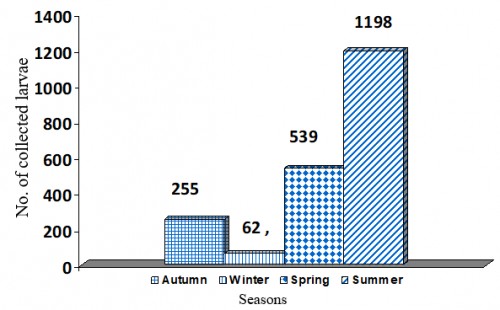Surveillance of mosquito vectors in Sana'a: Yemen
Author(s): Abbas Al-Azab, Essam Shaalan and Saleh Al-Elmani
Abstract: The mosquito fauna of Yemen is poorly studied and no modern taxonomic keys to mosquitoes of this country are found. This investigation was conducted to provide baseline data about mosquito vectors prevailing in Sana'a, north-west of Yemen. Immature stages of mosquitoes breeding in different aquatic habitats were collected seasonally from nine locations in Sana'a. Results indicated that 2054 mosquito larvae were collected by dipping method during 2015-2016, representing six culicine mosquito species belonging to 3 genera whilst no anopheline mosquito larvae were found. Depending on morphological keys of the fourth instar larvae, such mosquito species were identified as Culiseta longiareolata (980 larvae = 47.71%), Culex pipiens (559 larvae = 27.22%), Culex mattinglyi (252 larvae = 12.27%) Culex laticinctus (207 larvae = 10.08%), Culex (lutzia) tigripes (34 larvae = 1.67 %), and Aedes aegypti (22 larvae = 1.07%). Both Cs. longiareolata and Cx. pipiens were the most predominant species that found in all locations whilst both Ae. aegypti and Cx. (lutzia) tigripes were found in only one location, Sana'a city and Al-Haymah Ad Dakhiliyah respectively. Out of the six mosquito species, five (Cs. longiareolata, Cx. pipiens, Culex laticinctus, Culex mattinglyi and Ae. aegypti) are important vectors of diseases and 2 (Cx. (lutzia) tigripes and Cs. longiareolata) are predaceous in their larval stages. Additionally, both the dengue vector, Ae. aegypti, and the predaceous mosquito, Cx. (lutzia) tigripes, were detected for the first time in Sana'a city.Present findings highlighting the importance of regular mosquito surveillance in recording new species as well as identifying mosquito vectors and their preferable breeding sites. Hence, a satisfactory mosquito control program can be raised. Future extensive surveys, studies of cytogenetic and molecular analysis in addition to predation potential of predaceous mosquito larvae are recommended.
 Fig.:
Fig.: Seasonal abundance of mosquito larvae collected during 2015-2016 in Sana'a, Yemen.
How to cite this article:
Abbas Al-Azab, Essam Shaalan, Saleh Al-Elmani. Surveillance of mosquito vectors in Sana'a: Yemen. Int J Mosq Res 2019;6(1):124-131.



